Stratford on Avon Railway
The Stratford on Avon Railway[note 1] was a branch railway line opened in 1860, to connect the town to the Great Western Railway main line at Hatton, in England. It was worked by the GWR. In 1861 it was connected through Stratford on Avon to a branch line from Honeybourne, and this later enabled the development of a through mineral traffic. The company was absorbed by the GWR in 1883.
In 1906 a trunk route was opened from Honeybourne to Cheltenham, so that the GWR now had an independent route from Birmingham to Bristol, partly over the Stratford Railway, which was modernised for the purpose. In 1907-1908 the GWR’s position was further enhanced when North Warwickshire Line opened, making a shorter route from Birmingham and joining the original line at Bearley . The heavy mineral traffic, and later the through passenger traffic, was diverted away from the line, and it was curtailed at Stratford. It remains in passenger use as the Stratford upon Avon branch of the Chiltern Main Line, and the Stratford end of the North Warwickshire Line.
Origins
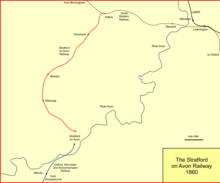
In a period of considerable railway construction following restoration of confidence in railway projects, two main lines were built, each passing about ten miles from Stratford on Avon.
The Great Western Railway built a trunk line, originally titled the Birmingham and Oxford Junction Railway, which formed the GWR's Birmingham main line. It opened on 1 October 1852, as a mixed gauge double track. It passed through Leamington, to the north-east of Stratford-on-Avon.[1]
OW&WR branch from Honeybourne
The Oxford, Worcester and Wolverhampton Railway opened its main line throughout in 1854; it passed through Honeybourne, somewhat to the east of Evesham. The OW&WR had decided to construct a branch line to Stratford from Honeybourne, and it opened the line to the public on 12 July 1859. It was a narrow (standard) gauge line. The Stratford station was on the south side of the town, at Sancta Lane.[2][3][4]
Stratford-on-Avon railway
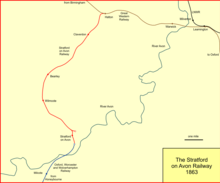
While the OW&WR branch line was under construction, interested parties promoted the Stratford-on-Avon Railway. This was to run to Stratford from the GWR (Birmingham and Oxford) line at Hatton, to the west of Leamington. It was authorised as a mixed gauge railway by an Act of 10 August 1857, with authorised capital of £65,000.[note 2] It opened on 10 October 1860, following a ceremonial opening the previous day. It was worked by the Great Western Railway from the outset. Intermediate stations were provided at Wilmcote, Bearley and Claverdon. The Stratford-on-Avon terminus was a timber-built train shed at Birmingham Road, north of the town.[5][6][7][8][9]
Connecting the branches
_(26564284718).jpg)
There were now two Stratford branches approaching the town from opposite directions, and there was a gap between them. On 24 July 1861 the line was extended from the OW&WR's temporary terminus to a junction with the Stratford on Avon railway.[6][3] The link was made by the Stratford-on-Avon Railway.[8] At first the connecting line used the OW&WR station, which was temporary, and by-passed the original Stratford-on-Avon Railway terminal at Birmingham Road; trains may have reversed into it from the connecting line. Through trains started running between Leamington, Worcester and Malvern from 1 August 1861.[3]
New Stratford station
A new Stratford-on-Avon joint station was opened on 1 January 1863, used by the GWR and the OW&WR. The original SoAR terminal became a goods depot from the same day. The new station was Italianate in design with a hipped, overhanging roof in Brunel's early style. Also on the same day broad gauge operation on the GWR lines was discontinued, although the broad gauge rails remained in situ on the branch for six years.[5]
Company amalgamations
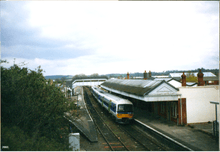
The OW&WR and the GWR had not always had good relations; the OW&WR joined with other railways to form the West Midland Railway in 1860. The WMR became friendly with the GWR, and in fact was leased by the GWR from 1 July 1861; the two companies merged on 1 August 1863, taking the title Great Western Railway for the combined company.[10]
The Stratford-on-Avon Railway company was amalgamated with the Great Western Railway by an Act of 1 July 1883.[11][8]
Alcester Railway
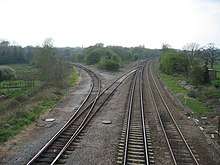
The Alcester Railway was authorised on 6 August 1872 to build a line from the Stratford on Avon Railway at Bearley, to Alcester. It opened on 4 September 1876. At this time both the Stratford-on-Avon Railway and the Alcester Railway were dependencies of the Great Western Railway, and they were both worked by that company. The Alcester trains shuttled from Bearley to Alcester, though some ran through over the Stratford Railway to Leamington.
On 22 July 1878 the Alcester Railway was acquired by the GWR and the SoAR jointly; the SoAR was itself absorbed by the GWR on 1 July 1883, by an Act of 20 August 1883.[12][13]
Stratford-upon-Avon and Midland Junction Railway
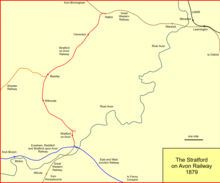
The East and West Junction Railway was conceived to convey Northamptonshire iron ore to South Wales, but it never fully achieved that aim. It opened from Fenny Compton through to the GWR at Stratford-on-Avon on 1 July 1873. The company was desperately short of money during construction and after opening. It opened its own Stratford station in June 1875, but passenger traffic was suspended from 31 July 1877 until 22 March 1885.[14][9]
The Evesham, Redditch and Stratford-upon-Avon Junction Railway obtained an Act to build a line from Stratford-upon-Avon to Broom Junction on 5 August 1873. It opened its line on 2 June 1879 and was worked by the E&WJR.[15]
In 1908 the Stratford-upon-Avon and Midland Junction Railway was formed from amalgamation of the East and West Junction Railway, the Evesham, Redditch and Stratford-upon-Avon Junction Railway and the Stratford-upon-Avon, Towcester and Midland Junction Railway.[16] The Broom Junction to Stratford-upon-Avon passenger service was withdrawn on 16 June 1947,[17] followed by the passenger service east of Stratford on 7 April 1952.[18][9]
Hatton North Curve
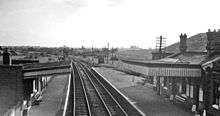
A North Curve was installed at Hatton, forming a triangular junction and giving a direct run towards Birmingham came into use on 1 July 1897. The GWR accelerated its services between Birmingham and Stratford using the curve, and bringing the fastest time to about forty minutes.[19]
Cheltenham and Honeybourne line
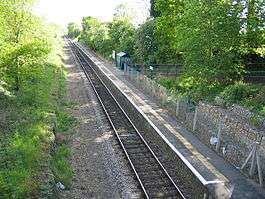
On 1 August 1899, the GWR obtained an authorising Act for a high speed line from Honeybourne to Cheltenham; the maximum gradient was to be 1 in 108 and the tightest curve radius was to be half a mile. The powers included doubling the Stratford Railway between Stratford and Bearley, and forming a new curve there to connect with the North Warwickshire Line.[20]
The new line opened progressively, between 1904 and 1 August 1906. This gave the GWR a route between Birmingham and Bristol via Stratford and Cheltenham independent of the Midland Railway.[21][22] Stratford station was enlarged, a footbridge provided, and awnings were added over the platforms in 1899.[5]
With the creation of the new route from Birmingham to Cheltenham early in the twentieth century, double track from Bearley to Stratford was brought into use on 9 December 1907.[5] Through long-distance express passenger trains started running on the route on 1 July 1908.[23]
North Warwickshire Railway
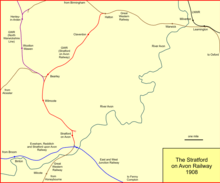
In the 1880s and later there was growing dissatisfaction with the service provided by the Great Western Railway in its area of influence. A direct line to Stratford, the Birmingham, North Warwickshire & Stratford on Avon Railway, was authorised on 25 August 1894, but the finance was not available to proceed. By a later Act of 30 July 1900 the authorisation was transferred to the Great Western Railway. The line was to link to the GWR at Bearley North Junction on the Stratford Railway. The line was opened on 9 December 1907 for goods, and on 1 July 1908 for passengers. The new Bearley North Curve was opened on the same day.[24][25]
Train service
The local passenger train service has been fairly constant over the years:
- 1887: 8 Down, 9 Up, Sundays 2, journey time 25 minutes;
- 1910: 10 each way, Sundays 2, journey time 20 minutes;
- 1922: 10 each way, Sundays 3, journey time 20 minutes;
- 1938: 13 each way, Sundays 6, journey time 19 minutes;
- 1993: 9 Up, 8 Down, Sundays 5, journey time 12 minutes.[5]
Semmens describes the long-distance services on the Birmingham – Stratford – Honeybourne route:
In 1922 there were five through southbound trains a day, with a fifth between Birmingham and Swansea. They all called at Stratford for two to five minutes on their way to the stop at... Cheltenham at the south end of the Great Western’s 1906 line... By 1939 the number of Birmingham-Bristol trains on ordinary week-days had fallen to four, [and] one to Swansea... However, as with other West of England services, there had been an explosion of Saturdays-only trains, in this case amounting to another six southbound ones.[26]
In 1934 streamlined diesel railcars started operating between Birmingham and Cardiff on the route. Three twin-engined cars equipped with buffets provided fast business services on the route.[26]
Track improvements
On 2 July 1939 double track was commissioned between Bearley and Hatton. As part of the work, the original Claverdon passenger station was closed and replaced by a new one west of the overbridge.[5]
William Shakespeare express
In 1951 an express service from London was run; it was titled the "William Shakespeare Express", and it used some of the first British Railways Standard coaches. The main part of the train ran from Paddington to Wolverhampton, but three coaches were uncoupled at Leamington and taken on to Stratford, often by 2-6-2T No. 4112. The venture was a commercial failure and the title vanished at the end of that summer service.[5]
Renaming
Stratford-on-Avon station was renamed Stratford-upon-Avon on 18 June 1951.[5]
Closure of the Honeybourne services
The route via Stratford continued to be heavily used for long-distance passenger services, but the drive for rationalisation eventually resulted in diversion of through Birmingham to Bristol trains to the Ashchurch (former Midland Railway) route. From 10 September 1962 "The Cornishman" and the South Wales diesel multiple unit trains were diverted via Ashchurch, but summer-only trains continued to use the Honeybourne route on Friday nights and Saturdays until 1966. The Cheltenham line closed completely on 25 August 1976.[27]
Diversion from SoA&MJR
On 7 March 1960 the connection at Fenny Compton was remodelled to provide a facing connection in order to form a route for the running of 800-ton iron ore trains from Banbury to South Wales. A new east-to-south curve was installed at Stratford-upon-Avon for the service. This curve opened on 24 April 1960 and the mineral flow operated from on 12 June 1960. The line from Stratford to Broom Junction was closed the following day.[28][29]
Closure of Stratford goods station
The original terminal station of the Stratford-on-Avon Railway had been reduced to a goods station when the through line was opened; it continued in use until 6th May 1968 when it closed.[5]
Rationalisation
The Hatton North Curve was singled on 22 September 1968.[5]
The double track between Bearley and Hatton was reduced to single on 12 January 1969, only one platform at Bearley remaining in use.[5]
The through line from Stratford to Honeybourne closed in 1976, and Stratford station became a terminus.[5]
Stratford Parkway station
A new station called Stratford-upon-Avon Parkway opened on 19 May 2013, on the north-west margin of the town near the A46 road.[30]
Station list
- Hatton junctions;
- Claverdon; opened 10 October 1860; still open;
- Bearley; opened 10 October 1860; still open;
- Wilmcote; opened 10 October 1860; still open;
- Stratford-upon-Avon Parkway; opened 19 May 2013; still open;
- Stratford on Avon (first station); opened 10 October 1860; closed 1 January 1863;
- Stratford on Avon; station on through line; opened 1 January 1863; renamed Stratford-upon-Avon 18 June 1951; still open (as a terminus).[4][31][32]
Notes
- The railway industry locally used the name Stratford on Avon, with or without hyphens, until 1951 from when Stratford upon Avon was used.
- Carter says "together with a 3⁄8 mile branch."
References
- MacDermot 1927, p. 327.
- Gammell, C.J. (1995). GWR Branch Lines. Sparkford: Oxford Publishing Co. pp. 96 and 98. ISBN 0-86093-521-3.
- Maggs 1994, p. 102.
- Quick, Michael (2002). Railway Passenger Stations in England, Scotland and Wales: A Chronology. Richmond, Surrey: the Railway and Canal Historical Society.
- Maggs 1994, pp. 107–108.
- Grant 2017, p. 542.
- Carter 1959, p. 283.
- MacDermot 1927, pp. 437–438.
- Goode 1978, p. 10.
- Carter 1959, p. 97.
- Carter 1959, p. 284.
- Essery, R.J. (2002). An Illustrated History of the Ashchurch to Barnt Green Line: The Evesham Route. Hersham: Oxford Publishing Company. p. 29. ISBN 0-86093-562-0.
- Grant 2017, p. 8.
- Riley & Simpson 1999, p. 12.
- Riley & Simpson 1999, p. 13.
- Riley & Simpson 1999, p. 59.
- Riley & Simpson 1999, p. 102.
- Riley & Simpson 1999, p. 152.
- Goode 1978, p. 12.
- MacDermotII, p. 420.
- Mitchell, Vic; Smith, Keith (1988). Stratford upon Avon to Cheltenham. Midhurst: Middleton Press. ISBN 1-901706-25-7.
- MacDermotII, p. 434.
- MacDermotII, p. 612.
- Grant 2017, p. 47–48.
- MacDermotII, pp. 611–612.
- Semmens, P.W.B. (1990). The Heyday of GWR Train Services. Newton Abbot: David & Charles Publishers plc. pp. 82–83. ISBN 0-7153-9109-7.
- Maggs, Colin G. (2010). Gloucestershire Railways. Wellington: Halsgrove. p. 111. ISBN 978-1-84114-913-4.
- Maggs 1994, pp. 70–71.
- Riley & Simpson 1999, p. 115.
- "Stratford-upon-Avon Parkway station opens". Railway Gazette. 21 May 2013.
- Cobb, Col M.H. (2002). The Railways of Great Britain: A Historical Atlas. Shepperton: Ian Allan Limited.
- Cooke, R.A. (1997). Atlas of the Great Western Railway as at 1947. Didcot: Wild Swan Publications. ISBN 0-906867-65-7.
- Carter, Ernest F. (1959). An Historical Geography of the Railways of the British Isles. London: Cassell.
- Goode, C.T. (1978). The North Warwickshire Railway. Usk: Oakwood Press.
- Grant, Donald J. (2017). Directory of the Railway Companies of Great Britain. Kibworth Beauchamp: Matador Publishers. ISBN 978-1785893-537.
- MacDermot, E.T. (1927). History of the Great Western Railway. volume I. London: Great Western Railway.
- MacDermot, E.T. History of the Great Western Railway. volume II. London: Great Western Railway.
- Maggs, Colin G. (1994). Branch Lines of Warwickshire. Stroud: Alan Sutton Publishing. ISBN 0-7509-0317-1.
- Riley, R.C.; Simpson, Bill (1999). A History of the Stratford-upon-Avon & Midland Junction Railway. Banbury: Lamplight Publications. ISBN 1-899246-04-5.